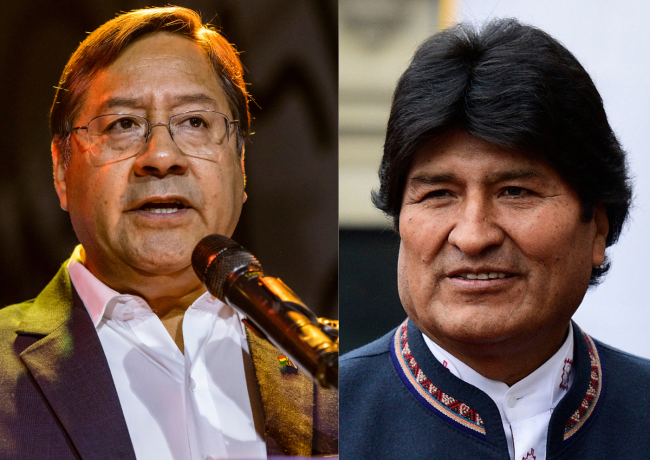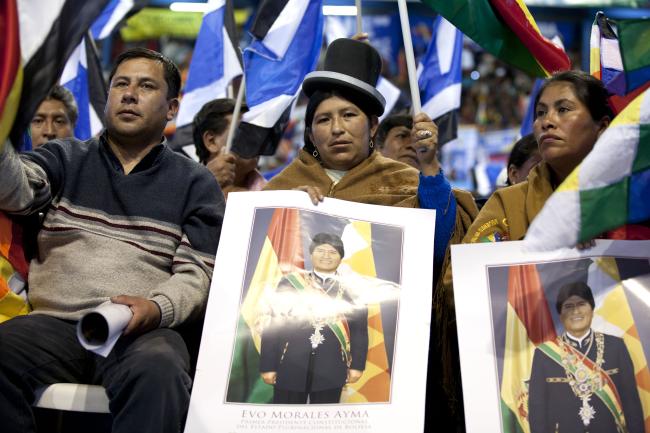
Leer este artículo en español.
Bolivia’s most important political force since its 1952 revolution, the Movimiento al Socialismo (MAS), is tearing itself apart. Leadership rifts threaten not only the party, but the political project and unity of the social movements that thrust the MAS unexpectedly into office in 2005.
Ex-President Evo Morales, the country’s first Indigenous president, is determined to be his party’s candidate in 2025. Opposing him are his former finance minister, current president and UK-educated economist Luis "Lucho" Arce Catacora, and Indigenous activist and Vice President David Choquehuanca, who worked as foreign minister under Morales for 11 years. But this leadership struggle is not only between the more moderate Lucho and radical Evo, it is economic as well. A decline in natural gas production, which has been the MAS government’s main revenue source, has the two factions quarreling over access to shrinking state funds.
The depth of the division was evident on November 14, when Morales’s faction made an alliance with the conservative opposition in the legislative assembly to block the national budget. Without naming names, Arce denounced those “trying to silence the voice of our founding organizations,” referring to the principal social movement creators and longtime supporters of the MAS, the Pacto Unidad (Unity Pact).
A September poll shows that among possible presidential candidates, Arce would win 18 percent of the vote and Morales 9 percent. The decline in Evo’s popularity was unmistakable well before Bolivia’s contested 2019 elections. As natural gas installer Damian López explained in a 2019 interview: “We want the process that Evo and his political movement started to continue, but it’s time for him to go and a new generation of leaders to replace him.”
Roots of the Current Crisis
That sentiment underpins the current crisis, which traces its immediate roots to 2016, when Morales narrowly lost a referendum to run for a constitutionally prohibited fourth term. His rejection of the results empowered the centrist and right-wing opposition to accuse of him of fraud during the October 2019 elections.
During three weeks of right-wing protest against Morales’s 2019 electoral victory, his traditional social movement base was conspicuously absent from the streets. Economist Armando Ortuno describes the delayed response as “a strange indifference, a demobilization, an ‘I don’t care’ attitude or a mature distance.” A combination of factors fed the lukewarm response: an expanded middle class whose interests had become more individualistic and consumer-oriented, weakened social movements, younger voters who did not identify with Evo as their parents had, and voter fatigue after 14 years of the MAS in office. “When the policies of a left government transform the material conditions of the poor, enabling class ascendancy, the collective imagination changes,” former Vice President Álvaro García Linera acknowledged in an interview just before the contested 2019 election.
After Evo was expelled unconstitutionally from office, Bible-thumping Jeanine Áñez was sworn in. Her authoritarian and incompetent transitional government immediately unleashed the military on the unarmed demonstrators who had mobilized to protest Morales’s ouster, killing about 30 people.
When long-delayed elections were finally promised by the de-facto government for May 2020, the country’s social movements opted for an electoral ticket represented by Choquehuanca and Andrónico Rodríguez, in hopes of replacing Morales with new leadership. Rodríguez, a 35-year-old coca grower from the Chapare, is vice president of the most important coca growers’ association and currently heads Bolivia’s Senate. Morales and García Linera nixed the social movements’ choice from exile in Buenos Aires and opted for Arce and Choquehuanca instead.
Morales and his supporters always saw the new president and vice president as interim leaders. “It’s your turn, Luis,” said García Linera in 2019, “then (leadership) passes to the legitimate owners, the peasants and Indigenous people of this country.” But Arce and Choquehuanca were determined to govern independently. “The ball is in our court,” Lucho declared unequivocally. This infuriated Evo, who saw in Arce the principal obstacle to his return to presidential power in 2025. Since then, the division within a party that has little institutional solidity and revolves around personal loyalties has only grown, with Evo proclaiming repeatedly that “The MAS is not in this government.”
When García Linera stepped into the fray last March, calling for negotiation between the two warring blocs and, harking back to the reason the MAS was formed in 1995, pleaded for “the continuation of a transformative social project,” Morales turned on him. Even though he had been his closest confidant, Evo promptly called his former vice president just “one more enemy”.

The Mythical Male Leader
During Morales’s 14 years in office, the MAS was unable to identify a successor, and those who might have assumed the role found themselves sidelined. This failure is often laid squarely at Morales’s feet, but Bolivia has never had much success in developing mechanisms to thwart individuals from concentrating power in their hands. The last time a political party handed off power between leaders was 35 years ago, and prior to that, 33 years earlier, in 1956. Both transitions—between Víctor Paz Estenssoro and Hernán Siles Zuazo in the 1950s and Paz Estenssorro and Gonzalo Sánchez de Lozada in 1989—were within Bolivia’s longest standing political party, the now largely defunct Movimiento Nacionalista Revolucionario (MNR), that had been the leading force behind the 1952 revolution.
Even though he is no longer in office, Morales’s power is indisputable: he remains the head of the MAS party and of the powerful Chapare coca grower unions. While Bolivia’s Indigenous and union organizations, particularly at the local level, prioritize the collective over the individual, insist on accountable leadership, and make participation mandatory, regional and national configurations—both worker and peasant—have frequently revolved around loyalty to a strong and charismatic male leader. This is often combined with a hearty dose of patronage and hierarchy, and a direct relationship between a leader and his followers, a model that Morales followed with roaring success. Evo’s constant visits to rural communities to inaugurate projects built him a strong following among the nation’s poorest that borders on the messianic.
Among more upwardly mobile urban dwellers, support leans toward Arce and Choquehuanca. “You’d be really lucky to find an Evista in El Alto,” retired professor and author Felix Muruchi told me in a Whatsapp message. “There aren’t any anymore.” This reflects a growing view outside the Chapare that sees Evo as divisive and disrespectful of the current president and, particularly, the vice president. Choquehuanca has strong backing in the predominantly Aymara city of El Alto, as well as in its rural hinterlands where he comes from.
On the other side of the clash, many in Morales’s coca farmer base in the Chapare are distrustful of President Arce, who has no strong social movement ties. Growers told anthropologist Tom Grisaffi in July of this year that they feared Arce’s government planned to bring back the hated U.S. Drug Enforcement Agency (DEA). “We are just waiting out the next two years for Lucho’s term to end, then we must bring Evo back,” insisted coca grower union leader Faustina Casillas. Another reason for the suspicion is the plunge in access to government funding that coca growers had benefited from during Morales’s presidency. Union leaders, such as former coca radio station reporter Alieta Ortiz, lost their government jobs.
Notwithstanding these grower concerns, the Arce administration adopted a four-year, $69 million development plan in 2021 aimed at the coca growers.
Between Arcistas and Evistas
The divide in the MAS endangers the hard-won and frequently tenuous unity among the country’s heterogenous social movements, who throughout history have jockeyed for national leadership. Bolivia’s movements have always been among the world’s most militant, with defiant resistance traditions dating from the Spanish invasion. Class-based and Indigenous movements were essential to Bolivia’s 1952 revolution, they compelled democracy’s return in 1982 after 18 years of dictatorship, and resolutely fought against the U.S.-backed war on drugs in the 1990s. In 2000 they blocked efforts to privatize Cochabamba’s water, and in 2003 they successfully mobilized against a plan to ship natural gas northward via Chile.
The “political instrument” that later became the MAS was regarded as the social movements’ electoral arm. “The idea was to form a party that could involve 100 percent of the bases [in making decisions] and that leaders would answer to us,” an ex-union leader told Grisaffi in 2005.
Once the MAS was in power, these movements pushed through one of the world’s most radical constitutions in 2009. Over the years of MAS rule, however, Bolivia’s social movements were steadily weakened through their incorporation, marginalization, and co-optation by the ruling party. But in the face of repression from the Áñez government in 2019-20, the impacts of the Covid-19 epidemic, and the MAS leadership being in exile or hiding, the same movements managed to regroup.
They not only re-asserted their centrality in the “process of change,” as the MAS political project is called, they forced new elections in October 2020 which Arce and Choquehuanca won handily with 55 percent of the vote. Their victory built on the MAS’s 14 years of success in overseeing the longest period of economic growth in the country’s history, as well as unparalleled political stability and a remarkable decline in poverty.
Arce and Choquehuanca set up a “technocratic” administration comprised of more professionals than under Morales, which, particularly at the beginning, had incorporated more social movement representatives in key government positions. Among the measures the Arce administration has adopted are a special tax on personal fortunes over $4.3 million, a payment to informal sector workers to help them recover from Covid that benefited a third of the population, equal pay for equal work for women, and taxes on agricultural imports in an effort to protect small-scale national production.
But the nasty squabble between Arcistas and Evistas menaces the MAS’s ability to stay in office. In August, at a congress of the largest peasant union confederation, the Confederación Sindical Única de Trabajadores Campesinos de Bolivia (CSUTCB), the two sides threw chairs and punched each other, causing over 450 injuries. To date, the only principal social movement organization to avoid splitting up is the labor federation, the Central Obrera Boliviana, which has declared loyalty to Arce and Choquehuanca.
At the beginning of October, a party congress was organized by coca growers determined to maintain their historic hegemony within the MAS. The Arcistas didn’t attend, most notably the “Interculturales” from Santa Cruz, a key MAS constituency that represents highland peasants who have migrated to the lowlands. In absentia, Arce and Choquehuanca were expelled from the party and informed they couldn’t compete in the 2025 national elections, and Morales was declared the MAS presidential candidate. This decision was soon overturned in the courts. Two weeks later, Arce and Choquehuanca demonstrated how much support they could garner by holding a large public meeting in El Alto that was attended by 100 organizations.
The outcome of this pitched battle remains uncertain. But what is clear is that if no resolution is reached, the greatest losers will be the social movements and their centuries-old project of social and economic justice. After far-right Javier Millei’s election in Argentina on November 19, Andrónico Rodríguez urged the MAS to resolve its crisis internally or jeopardize the 2025 elections. “We can’t put at risk the great transformations in the country that began in 2006,” he wrote on his X feed. “[We need] irreverence in [our] discussions, and unity in action.”
Linda Farthing is a journalist and independent scholar who has reported and commented from Bolivia for The Guardian, The Economist, Al Jazeera, Americas Quarterly, NPR and the BBC. She is co-author of four books on Bolivia; the latest with Thomas Becker is Coup: A Story of Violence and Resistance in Bolivia (Haymarket 2021).

